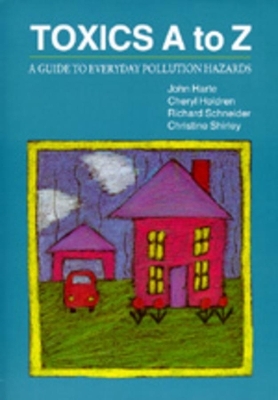
Toxics A to Z
University of California Press (Verlag)
978-0-520-07224-4 (ISBN)
- Lieferbar (Termin unbekannt)
- Versandkostenfrei innerhalb Deutschlands
- Auch auf Rechnung
- Verfügbarkeit in der Filiale vor Ort prüfen
- Artikel merken
* Toxics A to Z features and alphabetical listing of over 100 toxics, identifying ...* What they are* How they are measured* Where they are found* The symptoms of exposure* What their known risks are* How we can lessen or avoid those risks* An easy-to-use Cross-Reference Guide to help readers identify toxics in 18 major groups, including indoor and outdoor air pollutants, household items, and lawn and garden products* A glossary of terms, explanation of abbreviations, and listing of sources for further help and information
John Harte is professor and chair of the Energy and Resources Group at the University of California, Berkeley, where Richard Schneider and Christine Shirley completed their degrees. Harte is the author of many scientific papers and books, including The Green Fuse (California, 1993). Cheryl Holdren holds a Ph.D. from Stanford University. A population biologist, she specializes in insect and plat ecology.
How to Use This Book
Ten Effective Ways to Reduce
Toxics in Your Environment
Preface
Acknowledgments
Cross-References to Entries
by Exposure
PART ONE
ALL ABOUT TOXICS
FUNDAMENTALS
1 Toxics in Perspective
A. Thinking about Risk
B. Causes of Death and
Disease
2 The Language of Toxics
A. How Risk Is Described
B. Units Used to Describe
Toxics
SOME BASIC MEDICAL ASPECTS OF
THE TOXICS PROBLEM
3 Testing and Classification
of Toxics
A. Testing Toxics
B. Classification of Toxics
4 Toxics in the Body
A. Entry, Dose, and Exit: How
Chemicals Harm the Body
B. Sensitive Groups
C. Nutrition and Susceptibility
to Toxics
THE FOUR MAJOR SOURCES OF
TOXIC EXPOSURE
5 Toxics in Air
A. Air Pollution and Health
B. Smoking and Health
C. Indoor Air Pollution
6 Toxics in Water
A. Drinking Water and Health
B. The Threat from Below: Toxics
in Groundwater
7 Toxics in Food
A. Food Additives and Health
B. Why Alcohol and Other
Chemicals Don't Mix
C. Food and Cancer: How Much
Is Nature to Blame?
8 Toxics in Consumer Products
A. Inert Ingredients
B. Hobbies and Crafts
C. Some Product Comparisons
TOXICS AND THE ENVIRONMENT
9 Movement of Toxics through
the Environment
A. Air
B. Water
C. Soil
10 Toxics in the Biosphere
A. How Toxic Concentrations
Build Up in Animals
B. Ecological Effects of
Toxics
11 Three Global Environmental
Hazards of Pollutants
A. The Greenhouse Effect
B. Stratospheric Ozone
Depletion
C. Acid Rain
FOUR SPECIAL GROUPS OF TOXICS
12 Toxic Metals
A. Significance and Sources of
Toxic Metals
B. Human Health Effects
13 Petrochemicals
A. Sources and Products
B. Solvents
14 Pesticides
A. Overview
B. Classification and Patterns
of Use
C. Human Health Concerns
D. Environmental and Economic
Constraints
E. Cotton: A Case Study
F. Alternatives to Conventional
Pest Control
15 Radiation
A. The Nature of Radioactivity
B. The Electromagnetic
Spectrum
C. How Radiation Affects Us
D. Nuclear Fission and Nuclear
Fusion
E. Units Used to Describe
Radiation
F. Background Exposure and
Radiation Standards
G. Estimating the Risk of
Radiation
H. Food Irradiation
I. Nuclear War
MANAGING TOXICS
16 The Waste Crisis: Sources
and Solutions
A. Overview of the Waste Crisis
B. Waste Disposal
C. Waste Processing
D. Recycling and Other Approaches
to Source Reduction
17 Regulating Toxics
A. The Regulations: An
Overview
B. Protection of Air Quality
C. Protection of Water Quality
D. Public Health and Safety
E. Waste Management
F. Additional Laws Recently
Passed or Under
Consideration
G. The Right to Know about
Toxics
PART TWO
A GUIDE TO COMMONLY
ENCOUNTERED TOXICS
acetic acid
acetone
acrolein
aflatoxins
alachlor
aldicarb
aldrin and dieldrin
aluminum
ammonia
arsenic
asbestos
aspartame
asphalt
azinophos-methyl
barium
benomyl
benzene
benzo[ a ]pyrene (B[ a] P)
beryllium
BHT and BHA
bis(chloromethyl)ether
cadmium
caffeine
captan, captafol, and folpet
carbaryl
carbon black
carbon monoxide
carbon tetrachloride
carrageenan
cesium-137
CFCs
chlordane
chlorine, hydrogen chloride, hydrochloric
acid, and hypochlorite
chloroform
chromium
creosote
2,4-D
daminozide
DDT
diazinon
dicamba
dichlorvos
dioxane
dioxin
Di(2-ethylhexyl )phthalate
EBDCs: mancozeb, maneb, metiram,
and zineb
ethylene dibromide (EDB) and ethylene
dichloride (EDC)
ethylene glycol
ethylene oxide
extremely low frequency electromagnetic
fields
fluoride
food colors
formaldehyde
fosetyl AI
glyphosate
heptachlor
hydroquinone
iodine-131
laser light
lead
lindane
malathion
mercury
methyl ethyl ketone
methylene chloride
microwave and radio frequency
radiation
mineral fibers (nonasbestos)
monosodium glutamate (MSG)
naphthalene
nickel
nicotine
nitrates, nitrites, and nitrosamines
nitrogen oxides
noise
oxalic acid
ozone and other photochemical
oxidants
paraquat
parathion and methyl-parathion
particulate matter
PCBs and PBBs
plutonium
pyrethroids (pyrethrum and
permethrin)
radon
saccharin
selenium
sodium hydroxide
strontium-90
styrene
sulfites
sulfur dioxide and sulfates
2,4,5-T
tetrachloroethylene
toluene
trichloroethane
trichloroethylene
TRIS
tritium
ultrasound
ultraviolet radiation
vinyl chloride
vinylidene chloride
warfarin
xylene
zinc
Glossary
Commonly Used Abbreviations
for Units
Abbreviations for Environmental
Laws and Institutions
Annotated Suggested Readings
Sources for Home Testing
Equipment
National Hodines
Index
| Erscheint lt. Verlag | 9.9.1991 |
|---|---|
| Verlagsort | Berkerley |
| Sprache | englisch |
| Maße | 178 x 254 mm |
| Gewicht | 862 g |
| Themenwelt | Studium ► 2. Studienabschnitt (Klinik) ► Pharmakologie / Toxikologie |
| Naturwissenschaften ► Biologie ► Ökologie / Naturschutz | |
| ISBN-10 | 0-520-07224-3 / 0520072243 |
| ISBN-13 | 978-0-520-07224-4 / 9780520072244 |
| Zustand | Neuware |
| Haben Sie eine Frage zum Produkt? |
aus dem Bereich


